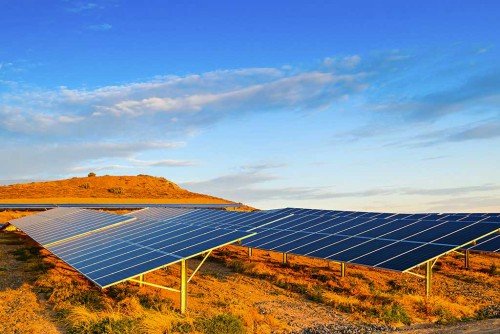
Australia is a country that has been grappling with the challenges of transitioning towards renewable energy. The government has been trying to balance the country's economic needs and energy demands with the urgent need to address climate change. The shift towards renewable energy is necessary to reduce Australia's carbon emissions, which are among the highest in the world.
Egology, or the study of ecological systems and their interrelationships, is an important aspect of the transition towards green energy. Egology helps us understand the impact of energy production on the environment and the ecosystem. In this blog post, we will explore the current state of green energy in Australia, the challenges and opportunities, and the role of egology in this transition.
Current State of Green Energy in Australia
According to the Australian Energy Statistics report, renewable energy made up 24.2% of Australia's electricity generation in 2019. The largest contributors to renewable energy were wind (7.1%), hydro (6.7%), and solar (6.5%). The country's renewable energy target is to generate 33,000 gigawatt-hours of electricity from renewable sources by 2020.
Australia has abundant renewable energy resources, including wind, solar, and geothermal. However, the country's renewable energy sector has been facing challenges in recent years. One of the main challenges has been the lack of policy certainty and support from the federal government. The government has been accused of favoring fossil fuel industries over renewable energy, which has hindered the growth of the green energy sector.
In addition to policy challenges, there are also technical and economic challenges to transitioning towards renewable energy. The intermittency of solar and wind energy, for example, requires energy storage technologies to be deployed on a large scale. The cost of renewable energy technologies, while decreasing, is still higher than that of fossil fuels, which can make the transition financially challenging.
Australia, known for its abundant natural resources, has been slow to adopt green energy despite being one of the sunniest and windiest countries in the world. However, in recent years, there has been a surge in the development of renewable energy sources, with the government and private sector making significant investments in clean energy technology. In this blog post, we will explore the current state of green energy in Australia.
Renewable Energy Targets
Australia has set a target of generating 50% of its electricity from renewable energy sources by 2030. This target is in line with the Paris Agreement, which aims to limit global warming to 1.5°C. The government has introduced a number of policies to encourage the development of renewable energy, including the Renewable Energy Target (RET) and the National Energy Guarantee (NEG). The RET requires energy retailers to source a certain amount of their electricity from renewable sources, while the NEG is designed to reduce greenhouse gas emissions and ensure energy security.
Solar Energy
Australia is one of the sunniest countries in the world, making it an ideal location for solar power. According to the Clean Energy Council, there are over 2.68 million solar panel installations in Australia, with a total capacity of over 21.6 GW. This makes Australia one of the highest per capita solar PV markets in the world. The government has also announced the implementation of a new program called the Solar Communities Program, which provides funding for community groups to install solar panels.
Wind Energy
Australia also has vast wind resources, particularly in coastal areas. According to the Australian Energy Market Operator (AEMO), wind energy accounts for approximately 8% of Australia’s total electricity generation. The largest wind farm in the southern hemisphere, the Snowtown Wind Farm, is located in South Australia and has a capacity of 370 MW. Other large wind farms in Australia include the Hornsdale Wind Farm in South Australia and the Macarthur Wind Farm in Victoria.
Hydro Energy
Hydro energy is another important source of renewable energy in Australia. The Snowy Mountains Hydro-Electric Scheme is the largest hydro power station in Australia, with a capacity of 4.1 GW. The scheme has been in operation since the 1950s and provides a significant proportion of the country’s renewable energy. There are also a number of smaller hydro power stations in Australia, including the Tarraleah Power Station in Tasmania and the Eildon Power Station in Victoria.
Challenges Facing the Green Energy Industry
While there has been significant progress in the development of green energy in Australia, there are still a number of challenges facing the industry. One of the biggest challenges is the lack of a coherent national energy policy. The NEG was designed to address this issue, but it was abandoned in 2018. This has created uncertainty in the industry, making it difficult for businesses to plan and invest in renewable energy.
Another challenge is the issue of intermittency. Solar and wind power are dependent on weather conditions, and their output can vary significantly from day to day. This can create challenges for energy grid operators, who need to ensure a stable supply of electricity. There is a need for better energy storage technology to address this issue, such as large-scale batteries or pumped hydro storage.
Finally, there is the issue of investment. While there has been significant investment in green energy in Australia, there is still a need for more funding to support the development of new technologies and infrastructure. The government has announced a number of funding initiatives, such as the Australian Renewable Energy Agency (ARENA) and the Clean Energy Finance Corporation (CEFC), but more needs to be done to attract private investment.
Challenges and Opportunities in the Transition towards Green Energy
The transition towards green energy in Australia presents both challenges and opportunities. The challenges are significant, as mentioned above, but the opportunities are also vast. The shift towards renewable energy has the potential to create jobs, reduce carbon emissions, and improve energy security.
One of the significant opportunities in the transition towards green energy is the potential for regional development. Many regions in Australia have abundant renewable energy resources, such as wind and solar, that can be harnessed for energy production. This presents an opportunity for the development of regional renewable energy industries and job creation in these areas.
Another opportunity is the potential for innovation and technological advancements. Australia has a strong research and development sector, which can be leveraged to develop and improve renewable energy technologies. There is also an opportunity for the deployment of energy storage technologies, such as batteries, which can help mitigate the intermittency of renewable energy.
Australia, like many other countries around the world, is grappling with the challenge of transitioning towards green energy. The need to shift from traditional sources of energy to clean, renewable energy sources has become urgent, as the impacts of climate change continue to worsen. The shift towards green energy presents both challenges and opportunities for Australia.
One of the main challenges facing Australia in the transition towards green energy is the country's heavy reliance on fossil fuels, particularly coal. Coal-fired power plants still provide the majority of Australia's electricity, and this reliance on coal is a significant barrier to the uptake of renewable energy. The challenge is to find a way to transition away from coal while maintaining energy security and affordability.
Another challenge is the need to invest in new infrastructure to support the transition towards green energy. This includes building new wind and solar farms, upgrading the electricity grid to handle increased renewable energy generation, and investing in energy storage technologies. These investments require significant funding, which may be difficult to secure in the current economic climate.
Despite these challenges, there are also many opportunities for Australia in the transition towards green energy. The country has abundant renewable energy resources, including some of the best solar and wind resources in the world. Australia also has a highly skilled workforce, which can be harnessed to develop and build the infrastructure needed to support the transition towards green energy.
The shift towards green energy also presents an opportunity for Australia to position itself as a leader in renewable energy technology and innovation. By investing in research and development, and by fostering an environment that supports innovation and entrepreneurship, Australia can create a thriving green energy industry that generates jobs and economic growth.
One key opportunity for Australia is in the export of renewable energy. As countries around the world look to transition towards green energy, there is growing demand for renewable energy technologies and expertise. Australia has the potential to become a major exporter of renewable energy, particularly to countries in the Asia-Pacific region.
To realise the opportunities presented by the transition towards green energy, Australia will need to take action on a number of fronts. This includes setting ambitious renewable energy targets, providing support for the development of renewable energy infrastructure, and investing in research and development to drive innovation in the green energy sector.
One important step that Australia can take is to develop a national energy policy that provides a clear roadmap for the transition towards green energy. A national energy policy can help to provide certainty for investors and businesses, and can help to drive the development of the infrastructure and technologies needed to support the transition towards green energy.
Another important step is to provide support for the communities and workers that will be impacted by the transition away from fossil fuels. This includes providing training and education opportunities for workers in the fossil fuel industry, as well as investing in new job creation and economic development initiatives in regions that are currently reliant on fossil fuel industries.
The transition towards green energy presents both challenges and opportunities for Australia. While the country's heavy reliance on fossil fuels presents a significant barrier to the uptake of renewable energy, Australia also has abundant renewable energy resources and a highly skilled workforce. By investing in the infrastructure and technologies needed to support the transition towards green energy, and by fostering an environment that supports innovation and entrepreneurship, Australia can create a thriving green energy industry that generates jobs and economic growth, and positions the country as a leader in renewable energy technology and innovation.
The Role of Egology in the Transition towards Green Energy
Egology plays a crucial role in the transition towards green energy in Australia. The study of ecological systems and their interrelationships helps us understand the impact of energy production on the environment and the ecosystem. This understanding is necessary to ensure that the shift towards renewable energy is sustainable and does not cause unintended negative consequences.
For example, the deployment of large-scale wind and solar farms can have significant impacts on local ecosystems. Egology can help us understand these impacts and develop strategies to mitigate them. For instance, studies have shown that the placement of wind turbines can impact bird populations and migration patterns. Understanding these impacts can help us develop strategies to mitigate them, such as the placement of wind turbines away from bird migration paths.
Another example of the role of egology in the transition towards green energy is in the deployment of energy storage technologies. The production and disposal of batteries can have environmental impacts that need to be understood and mitigated.








